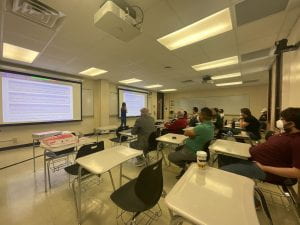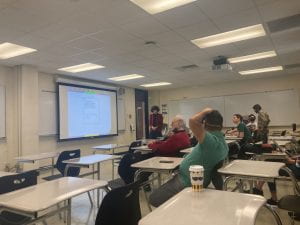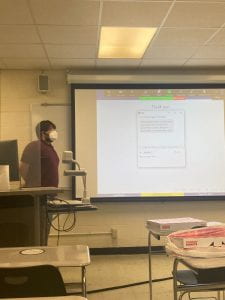A Marcinkiewicz-type Schur multiplier theorem in the Schatten-p class
Generalizations of Alladi’s formula for arithmetical semigroups
On the classification of generalized Baumslag-Solitar groups
Abstract: A generalized Baumslag-Solitar group (GBS group) is a group that acts on a tree with infinite cyclic edge and vertex stabilizers. Equivalently, it is the fundamental group of a graph of infinite cyclic groups. These groups have arisen in the study of splitting of groups. In this talk, we will discuss how to approach the group-theoretic classification of GBS groups and the current results of this problem.
A theorem by Peres and Schlag
Abstract: In this talk, we will prove that if ![]() is lacunary, i.e.
is lacunary, i.e. ![]() for every
for every ![]() , then we can find an irrational number
, then we can find an irrational number ![]() such that
such that
2022 Faudree’s Research day
Snapshots of the 2022 Faudree’s Research day








2021 Hugo Steinhaus Prize
Irena Lasiecka is a laureate of 2021 Hugo Steinhaus Prize awarded by the Polish Society of Mathematics.
2022 Carnegie R1 Research Celebration Event
The Faculty of the Department of Mathematical Sciences has been recognized during the 2022 Carnegie R1 Research Celebration Event held by the Provost of Research Office on April 7, 2022.
- In the category of FY 2021 Principal Investigators: I. Lasiecka, A. Windsor, and B. Zheng.
- In the category of FY 2021 Book Publications: G. Anastassiou.
- In the category of Research Impact Top Faculty by Scopus H index: I. Lasiecka [47], B. Bollobas [43] and R. Triggiani [39].
PDE seminar
Title: Global attractors for a nonlinear boundary damped wave equation with nonlinear critical source.
Speaker: Dr. Madhumita Roy
Abstract: In this talk we shall consider a wave model in 3D on a bounded domain which contains nonlinear sources with critical exponent in the interior and nonlinear feedback dissipation on the boundary. Similar models with simpler nonlinear boundary terms have been already studied broadly whereas the generosity of our model is not only the presence of nonlinear damping but also nonlinear boundary source. Boundary actuators are easily accessible to external manipulations-hence feasible from the engineering point of view and practically implementable. On the other hand, the underlying mathematics is challenging. Boundary actions are represented by unbounded, unclosable operators, hence not treatable by perturbation theory(even from the point of view of well-posedness theory.)
Our main result shows that a suitably calibrated boundary damping prevents the blow up of the waves and allows to contain these asymptotically (in time) in a suitable attracting set which is compact.
Time: Apr 15, 2022 02:00 PM Central Time (US and Canada)
Join Zoom Meeting
https://memphis.zoom.us/j/89234625016?pwd=S2hGbW5CZEJKNXZVbTc4bURhR21IZz09
Meeting ID: 892 3462 5016
Passcode: 363494
Ergodic Theory seminar: The Lightning Model
Title: The Lightning Model
Abstract: We introduce a non-standard model for percolation on the integer lattice $\Z^2$. Randomly assign to each vertex $a \in \Z^2$ a potential, denoted $\phi_a$, chosen independently and uniformly from the interval $[0, 1]$. For fixed $\epsilon \in [0,1]$, draw a directed edge from vertex $a$ to a nearest-neighbor vertex $b$ if $\phi_b < \phi_a + \ep$, yielding a directed subgraph of the infinite directed graph $\overrightarrow{G}$ whose vertex set is $\Z^2$, with nearest-neighbor edge set. We define notions of weak and strong percolation for our model, and observe that when $\ep = 0$ the model fails to percolate weakly, while for $\ep = 1$ it percolates strongly. We show that there is a positive $\epsilon_0$ so that for $0 \le \ep \le \ep_0$, the model fails to percolate weakly, and that when $\ep > p_\text{site}$, the critical probability for standard site percolation in $\Z^2$, the model percolates strongly. We study the number of infinite strongly connected clusters occurring in a typical configuration. We show that for these models of percolation on directed graphs, there are some subtle issues that do not arise for undirected percolation. Although our model does not have the finite energy property, we are able to show that, as in the standard model, the number of infinite strongly connected clusters is almost surely 0, 1 or $\infty$.
Location: DH 109
Time: 4/14/2022 1:00 pm.